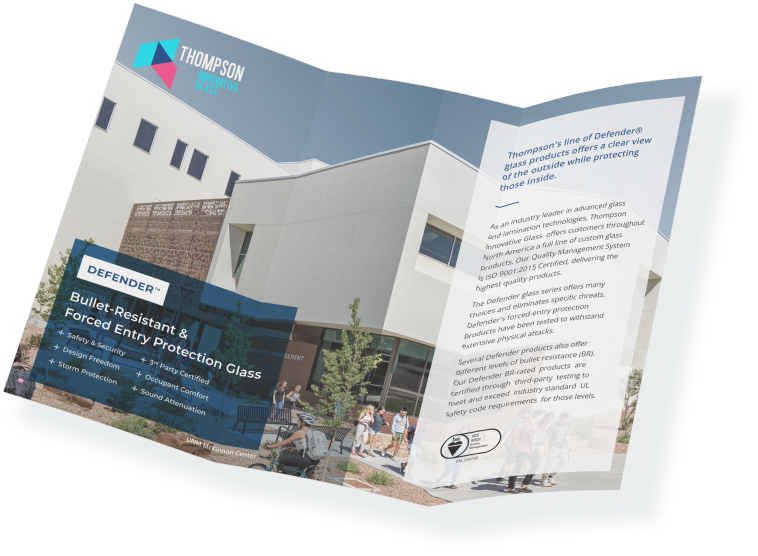Schools
Security glazing enhances school safety by resisting forced entry and delaying intruders, providing critical response time without compromising light, visibility, or design.
Thompson Innovative Glass manufactures several Safety Glass options including Forced Entry Glass under its Defender ® line.
Forced Entry Glass refers to a specialized type of glass that is designed to resist breakage or penetration attempts, typically through impact or blunt force. This glass is engineered for security purposes and is composed of layers of materials, such as laminated glass or a polycarbonate, that work together to absorb and dissipate energy when subjected to force.
These layers are bonded together, often with a tough interlayer, making the glass highly resistant to shattering or being compromised. Thompson Innovative Glass has tested our Defender products to the ASTM F1233 standard and continues development to provide the end user with the best possible options.
Defender forced entry glass features multiple make-ups and performance levels and can be combined with energy efficiency products as well as bird-friendly materials
Able to withstand blows from hammers, crowbars, or other tools typically used in break-in attempts.
While the glass may crack under extreme force, it remains intact rather than breaking into pieces, preventing entry.
The glass is built for long-term use, retaining its security properties over time.
Can come in various thicknesses and layers depending on the level of protection needed.
Bullet-resistant and forced entry glass are critical components in protecting people and property across a wide range of high-risk environments. These specialized glazing solutions are trusted wherever enhanced security and peace of mind are essential, from public institutions to private facilities. Common applications include:
Security glazing enhances school safety by resisting forced entry and delaying intruders, providing critical response time without compromising light, visibility, or design.
Healthcare environments use safety and security glazing in patient rooms, lobbies, and sensitive areas to enhance protection and hygiene without sacrificing light or openness.
These retail spaces utilize protective glass to deter crime and protect staff, particularly during overnight hours or high-traffic periods.
Glazing in correctional environments must meet rigorous standards for containment, safety, and visibility while withstanding impact and tampering.
These critical infrastructure locations require secure glazing systems to guard control rooms and equipment against potential attacks or natural hazards.
Bus, train, and transit stations need high-performance glass for public safety, blast mitigation, and clear communication in high-traffic zones.
Forced entry glass is specially designed to resist breakage or penetration attempts during a physical attack. It's function is to delay entrance by intruders, enhancing safety in residential, commercial, and institutional settings.
Forced entry glass typically combines laminated layers of glass with interlayers like polycarbonate or PVB. These materials absorb and distribute the force of an impact, preventing the glass from shattering easily or creating openings for entry.
Forced entry glass is tested according to standards like:
Yes, some forced entry glass products are designed to provide both forced entry resistance and ballistic protection. These products typically meet multiple safety standards, but not all forced entry glass is bullet-resistant. See more in our Defender section.
The thickness of forced entry glass depends on its rating and intended application.
Yes, it can often be retrofitted into existing frames. However, some retrofits may require structural modifications for optimal performance.
Standard glass is prone to shattering upon impact, while forced entry glass is designed to resist impacts, remain intact, and prevent easy access through the glass.
Yes, many forced entry glass products are available as insulated glass units (IGUs) with energy-efficient coatings, combining security with thermal performance.
Discover all Security Glass options in our brochure
Download Now